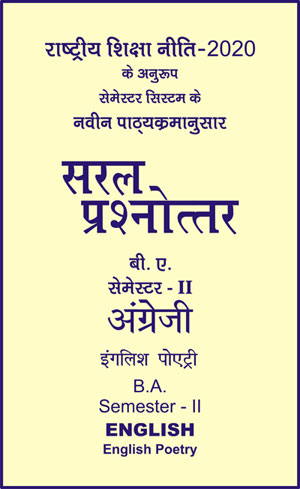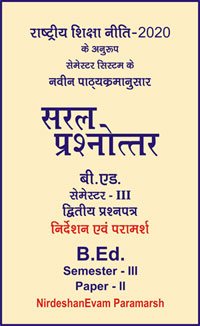|
बी ए - एम ए >> बीए सेमेस्टर-2 - अंग्रेजी - इंगलिश पोएट्री बीए सेमेस्टर-2 - अंग्रेजी - इंगलिश पोएट्रीसरल प्रश्नोत्तर समूह
|
|
|||||||
बीए सेमेस्टर-2 - अंग्रेजी - इंगलिश पोएट्री
Chapter - 10
"Break, Break, Break"
- Alfred Lord Tennyson
Life and Works of Alfred Lord Tennyson
Alfred Lord Tennyson was born on the 6th August 1809 in the Rectory at village Somersby in Lincolnshire. His father, Rev. George Clayton Tennyson was the Rector. At the age of seven he was sent to Louth Grammar school where he remained for four years. Later on he was educated at home along with his brother charles.
In the year, 1828, he took himself into Cambridge, where he met a man named Arthur Henry Hallam. Very soon he establihsed a friendship with him and this friendship changed into a relationship. In 1829 Hallam became engaged to Tennyson's sister Emily. But in 1833 a heavy blow fell upon him in the death of his friend Hallam. He also married Emily Sarah Sellwood. But gradually, attaining the accomplishments in the field of poetry, he came to an end in the year 1892 october 6.
First of all along with his brother Charles a small volume of poems entitled "Poems by Two Brothers" was published in 1827. In the year 1829. he brought out a small volume of poem called 'Poems'. In the year 1832 he published a volume of poems, and 'The Lotus Eaters,' Oenone, place of Art and Dream of Fair Woman, In 1847 he published "The princess.' in 1850 'In memoriam'as a result of his friend Arthur Hallam, in 1884 'The cup and Falcon'. in 1889 'Debheter' and other poems and in 1892 "The Death of Oeone' came.
Break Break Break
Introduction of the Poem
Break, Break, Break is one of the most lyrical and natural poems. It is best on "Tennyson's dearest friend, Henry Arthur Hallam. It was first published in 1842. Tennyson was very much grieved by the death of his friend Hallam. In this intensive grief he through this poem 'Break, Break, Break tries to ask the waves of the sea to strike against the old gray stones to became the sad passing away of his friend.
His friend, Hallam is dead and he tries to bemoan by telling the waves to participate in his mourning. The sea can express its grief but not the poet on account of its intensity. Life goes on uniformly in nature for the fisherman's boy shouts with hs sister at play and the sailor's lad sings in his boat on the bay. Only the poet will not be able to recover the joy of his early life lost in the death of Hallam. The poem is thus, full of pathos.
Substance to the Poem
Tennyson's Break, Break, Break is a short lyric poem in which nature serves as a mirror to the poet's intense feeling of sorrow on the death of his friend Henry Arthur Hallam. The poem has the reference to clevedon, a watering place on the Bristol channel, where Arthur Hallam was buried. Where the clevedon sea in torment reflects the mind of the poet in torment on the death of his only dear friend, Arthur Hallam. The poem is strongly emotional and is a great lament.
कविता का हिन्दी सारांश
टेनिसन की ब्रेक, ब्रेक, ब्रेक एक संक्षिप्त गीतमयी कविता है जिसमें प्राकृतिक दर्पण कवि के हृदय में अपने मित्र की मृत्यु एक शोकात्मक भाव उत्पन्न कर देती है। यह कविता Bristol Cannel नामक तट के Clevedon समुद्र के समीप उदघृत की गयी है, जहाँ कवि का मित्र Arthur Hallam दफन था । वहाँ Clevedon समुद्र की लहरें कवि के हृदय में व्याकुलता उत्पन्न कर देती है और उस व्याकुलता में कवि अपने प्रिय मित्र Arthur Hallam की याद में शोक व्याप्त करता है। अतः यह कविता अत्याधिक भावुक एवं दुखात्मक है।
Points to Ponder (About the poem)
1. Break, Break, Break has been written on the death of Tennyson's friend Henry Arthur Hallam.
2. The Clevedon sea inspires the poet's mind to write poem on the death of his friend.
3. The poem establishes the eternity of laws of Nature and life in Nature.
4. The poem is full of pathos and spontaneously overflow of the powerful feelings of the poet's grief recollected in tranquility.
|
|||||
- Chapter - 1 Forms of Poetry & Stanza Forms
- Objective Type Questions
- Answers
- Chapter - 2 Poetic Device
- Objective Type Questions
- Answers
- Chapter - 3 "Let Me Not to the Marriage of True Minds" (Sonnet No. 116)
- Objective Type Questions
- Answers
- Chapter - 4 "On His Blindness"
- Objective Type Questions
- Answers
- Chapter - 5 "Present in Absence"
- Objective Type Questions
- Answers
- Chapter - 6 "Essay on Man”
- Objective Type Questions
- Answers
- Chapter - 7 "Elegy Written in a Country Churchyard”
- Objective Type Questions
- Answers
- Chapter - 8 "The World is Too Much with Us"
- Objective Type Questions
- Answers
- Chapter - 9 "Ode on a Grecian Urn"
- Objective Type Questions
- Answers
- Chapter - 10 "Break, Break, Break"
- Objective Type Questions
- Answers
- Chapter - 11 "How Do I Love Thee?"
- Objective Type Questions
- Answers
- Chapter - 12 "Dover Beach"
- Objective Type Questions
- Answers
- Chapter - 13 "My Last Duchess'
- Objective Type Questions
- Answers
- Chapter - 14 "The Love Song of J. Alfred Prufrock"
- Objective Type Questions
- Answers
- Chapter - 15 "The Lake Isle of Innisfree"
- Objective Type Questions
- Answers
- Chapter - 16 "Church Going"
- Objective Type Questions
- Answers
- Chapter - 17 Rhetoric and Prosody - Practical Criticism
- Objective Type Questions
- Answers

 i
i 










